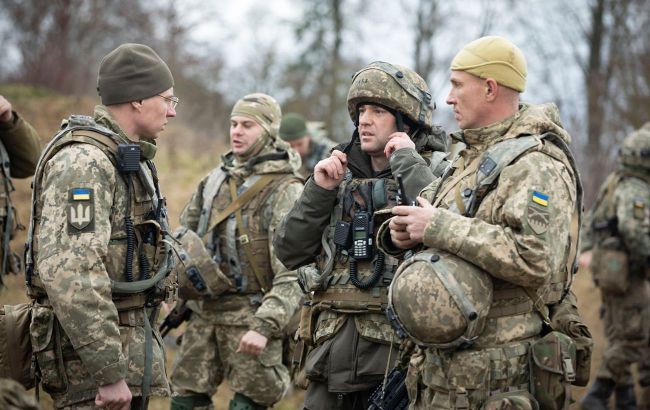Ukrainian army stabilizes front and begins limited counteroffensive by year-end
 The defense forces will be strengthened thanks to assistance from the US (photo: facebook.com/GeneralStaff.ua)
The defense forces will be strengthened thanks to assistance from the US (photo: facebook.com/GeneralStaff.ua)
Well-equipped with Western arms, the Ukrainian Armed Forces will be able to prevent significant operational advancement of Russian troops during the planned summer offensive operation. However, the Russian army will still use certain advantages and adaptations to pose a significant threat to the Defense Forces in the summer, according to a report by the Institute for the Study of War (ISW).
It is noted that during previous large-scale offensive operations in Ukraine, well-equipped Armed Forces did not allow the Russians to achieve even tactical successes. It is unlikely that the Russian army will conduct an offensive operation this summer that will be significantly larger and more intensive than previous offensives.
Quantity, not quality
ISW referred to a Western official who told the Financial Times that the Russian army remains ineffective with outdated equipment and poorly trained soldiers. According to the official, the Russian military has not significantly improved its level since the start of the invasion in February 2022.
However, the report notes that by evaluating the effectiveness of the Russian military solely on absolute quality, the Russians' use of their temporary relative advantages over Ukraine to create increasing stress for the Defense Forces is ignored.
It is noted that Russian military forces are facing limitations regarding the amount of modern and effective equipment they can and will be able to deploy in Ukraine, and the overall combat readiness of Russian units and formations continues to decline as they experience degradation.
Instead, the Russian forces partially rely on their numerical superiority in equipment and personnel to exert constant and increasing pressure on the Ukrainian Armed Forces (UAF) and, at the same time, accept losses that the Ukrainian army could not withstand.
"The Russian focus on mass, regardless of quality, has supported tactical Russian gains, especially as delays in Western security assistance have degraded Ukraine’s qualitative advantages over Russian forces, and Russian forces will likely use mass to achieve tactical advances against even well-provisioned Ukrainian forces this summer," the ISW report states.
At the same time, the Institute for the Study of War notes that the focus on quantity is not the only adaptation Russian forces have made in Ukraine, as Russian military personnel have demonstrated uneven propensity for operational, tactical, and technological innovations and training.
Russian military leadership seems to be learning from past mistakes in operational planning in Ukraine and is likely to conduct a summer offensive operation aimed at stretching and suppressing the UAF on a broader front in the country's east.
Guided bombs as a know-how
The report also notes that Russian forces have significantly changed their tactical aviation operations in Ukraine through the mass use of glide bombs, which allows aircraft to safely strike from deep behind enemy lines.
"These glide bomb strikes will continue to play a critically important role in supporting Russian ground operations this summer despite the likely improved air defense capabilities that Ukrainian forces will be able to leverage against Russian aircraft as additional Western air defense materiel arrives," ISW states.
The Institute's analysts also note that Russian forces continue widespread deployment of technological innovations across the front to support offensive actions, and they time the deployment of these innovations to exploit vulnerabilities in the UAF and gain advantages before Ukrainian forces can adapt to the Russian innovations. Russian forces are expected to use new technological or tactical innovations at the beginning of their summer offensive efforts to neutralize the stronger capabilities that the Defense Forces will gain after the arrival of US aid.
At the same time, ISW notes that Russian forces still suffer from widespread tactical mistakes, and Ukrainian forces can use this factor as long as the Russian military leadership continues to struggle with internalizing and spreading adaptations at the tactical level.
"Ukraine will be able to neutralize many of the material constraints it currently faces in the coming weeks and is taking steps to alleviate its manpower challenges in the coming months, but Russia will continue to pursue its own advantages as Ukrainian capabilities improve. Ukraine is very likely to stabilize the frontlines in the coming months and may be able to begin limited counteroffensive operations in late 2024 or early 2025," the ISW report concludes.
US aid and the situation on the front
Over the past six months, the Armed Forces of Ukraine have faced a severe shortage of weapons due to delays in the provision of US security aid. This allowed the Russians to capture the city of Avdiivka and several villages in the Donetsk region.
On April 20, the US House of Representatives approved a bill funding military aid to Ukraine, Israel, and Taiwan totaling $95 billion, with around $61 billion allocated for the material and defense needs of the Ukrainian Armed Forces.
On April 23, the bill was approved by the Senate, and on April 24, it was signed by President Joe Biden.
The US has already begun the rapid shipment of arms for Ukraine's defensive needs.
Recently, the Institute for the Study of War stated that the Ukrainian Armed Forces could reclaim all the territories they lost, but this would depend on the ability of all parties to dynamically change the course of the war.
To learn more about how US aid will change the situation on the front line and what people in Ukraine and the West think about it, read the article by RBC-Ukraine.

